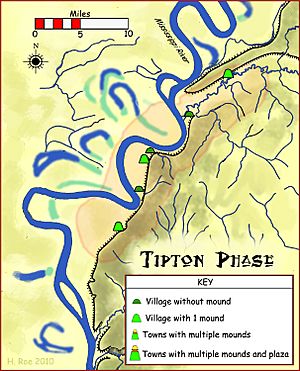Tipton phase facts for kids
The Tipton phase was a group of ancient people who lived in what is now southwestern Tennessee. They were part of the Late Mississippian culture, a big group of Native American societies that lived in the central and southeastern United States long ago. The Tipton phase people were the last known prehistoric group to live in this area before Europeans arrived.
They lived right across the Mississippi River from another group called the Nodena phase. They were also just north of the Walls phase people. In the early 1540s, the Hernando de Soto Expedition traveled through their land. This expedition was a group of European explorers. The Tipton phase is named after Tipton County, Tennessee, where many of their ancient sites have been found.
Contents
The Tipton Phase: Ancient People of Tennessee
The Tipton phase refers to a specific time and place where people shared a similar way of life. These people were part of the larger Mississippian culture. This culture was known for building large earthen mounds and for being skilled farmers. They grew crops like corn, beans, and squash.
Who Were the Tipton Phase People?
The people of the Tipton phase were Native Americans who lived in complex societies. They had villages, farmed the land, and created unique pottery and tools. They were one of several groups living in the area during the Late Mississippian period.
Other groups living around the same time included the Parkin phase, the Walls phase, the Menard phase, and the Nodena phase. These groups often traded with each other. They also sometimes competed for resources.
Where Did They Live?
The Tipton phase people lived in the southwestern part of Tennessee. Their land was very close to the mighty Mississippi River. This river was like a highway for them. It helped them travel and trade with other groups.
Living near the river also meant they had fertile land for farming. The river provided water for their crops. It also offered fish and other resources. Their villages were often built on high ground near the river.
What Happened When Europeans Arrived?
In the early 1540s, a Spanish explorer named Hernando de Soto led an expedition through the area. His group traveled through the lands of the Tipton phase people. They visited many villages along their journey.
The arrival of Europeans changed the lives of Native Americans forever. It brought new diseases that the native people had no protection against. It also led to big changes in their way of life. The Tipton phase people were the last known prehistoric group in this area before these major changes began.
How Do We Know About Them?
We know about the Tipton phase people because of archaeology. Archaeologists are like history detectives. They study the remains of past human life. They dig up old villages, tools, and pottery.
By studying these artifacts, archaeologists learn how these ancient people lived. They can figure out what they ate, what tools they used, and how their societies were organized. This helps us understand the rich history of Native Americans in Tennessee.


